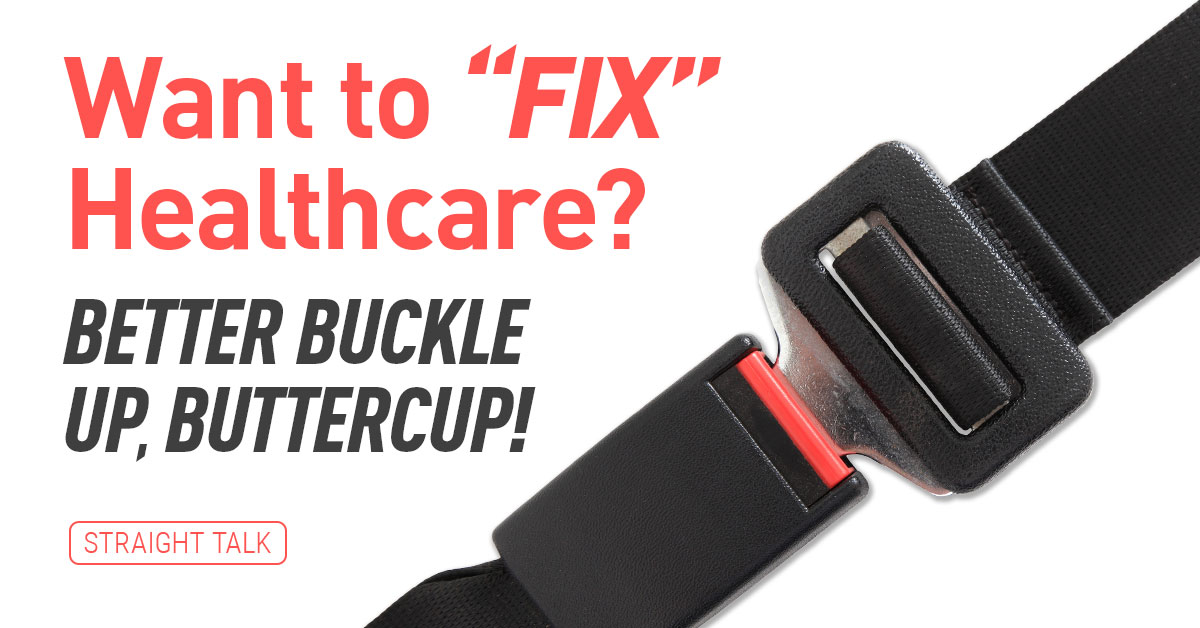Every year, giant companies that have been successful around the world doing non-healthcare-related things try to dip their toes into the healthcare business and “fix” it. And there are always new start-ups that try to “disrupt” healthcare or health insurance.
I’ve watched them for years. And from my experience, these groups fall into two categories:
- Technology companies that believe their new applications can revolutionize the way healthcare is paid for or delivered, thus saving lots of money; or
- Large companies with cash to burn investing in medical clinics, hospitals or drug companies with an eye toward “rationalizing” healthcare and making profits.
Montage Scene Here
When it’s done, they’ve spent billions of dollars, maneuvered the stock market, grown and extinguished fortunes. But what do they really have to show for it? From my viewpoint, in the long run, the players in healthcare don’t really change. Incumbents (like our 90-year-old Blue Cross and Blue Shield of Louisiana plan) soldier on at a fraction of the size of these new players and stay successfully in the healthcare game.
Every time one of these new disrupters or fixers comes along, I study its mission, look at what it’s targeting, reflect on the current industry and guess how long it will be around. I thought it might be interesting to share some of my observations with you.
Sounds like fun? Let’s give it a go!
TYPE ONE: THE NEW TECHNOLOGY COMPANY (Disrupters)
The progression of a disrupter has become pretty predictable. Venture capital or private equity investors are presented with a high-tech way to “disrupt” health insurance. Or maybe it’s a new gadget that is going to “revolutionize healthcare as we know it.” Presenters promise to make money for their investors. Convinced, investors give the disrupters lots of money up front, Wall Street is convinced, the company can issue stock and grow with the hope (hype?) that the whole effort can be profitable.
Some of these companies have initially raised tons of cash, and spent it building their own “lean, high-tech version of a health insurance player,” as I read in a prospectus not too long ago. The levels of investment can be huge, but that’s no guarantee of success. Just for fun, you can see a list of some of them here. And some health insurance start-ups turned out to be MUCH better at raising money than actually paying claims or enrolling members.
Expensive operations + big marketing expenditures + lower premiums ≠ profit.
You all know (because you’ve been reading Straight Talk for years!), that a health insurance carrier is required by federal law to spend between 80-85% of its inbound revenue on nothing but healthcare for its members. It seems most of the savings these disrupters seek to achieve are not in the 80-85% (which is dependent on how good you are at building networks and contracting with medical providers), but in the 15-20% of allowable overhead in our business.
Saving money on overhead is MUCH harder than it looks, and these companies often run into similar problems.
- Often these new disrupters are in a hurry to go to market and outsource many core functions of running a health insurance company, like customer service, provider relations, claims processing, etc. It may save time, but it costs more money.
- To attract new members, they have marketing budgets often three or four times higher than existing carriers. Without this huge marketing expenditure, they stand little chance of drawing customers away from legacy carriers with lots of name recognition.
- Finally, to get consumers to try them, their premiums must be lower, limiting their overall revenue.
For example, Oscar Health, (a well-funded technology disrupter now 11 years old) in their most recent financials, listed their overhead (on $6 billion in premiums) at 20% of revenue. Here at Blue Cross, we routinely run more like 15% overhead (on $4 billion in premiums). In a competitive situation, that’s very tough to overcome.
I’ve also noticed these tech companies often try to control costs by narrowing their provider networks to the least-expensive docs and hospitals and only selling in urban areas. Since this type of insurance is only suitable for people without complex medical needs, this can mean those companies must make federally mandated payments to other carriers whose larger networks service members who need more care (it’s called “risk adjustment”). If part of your profitability involves delaying your members getting care because of smaller networks, that’s a problem, too.
It’s a tough business, and I’ve seen very few of these venture capital/private equity-funded disrupters hang around more than four or five years. They do keep us on our toes and make fascinating reading for a nerd like me, but investors beware!
TYPE TWO: THE BIG GUYS (like Walmart and Amazon)
What about the BIG GUYS like Walmart and Amazon? Believe me, I understand the temptation of the big players. Imagine you’re a big company with billions in profits and you need to invest it in something. Healthcare is as big as it gets (like 19% of GDP!), so you ought to be able to make some money by investing in healthcare! And you can use all your earned efficiency and apply your skill set (that has been VERY successful in your business) to healthcare and show those already in the healthcare/health insurance business how it’s done! You’re gonna FIX healthcare.
Healthcare Is Hard to Break Into
I’ve never met a CEO who didn’t trust his or her gut. And this seems like a no-brainer. Until you get into it and see what the world surrounding the healthcare payment models, government regulations, and the existing payers and providers is really like. It certainly does resist “fixing” it.
There have been a lot of recent news reports about Walmart exiting their healthcare lines of business after five years of investment and opening 51 primary care clinics in six states. As a person who knows that we never have enough primary care resources to go around, this saddens me. As an economist who studies this business every single day, I am not surprised. Walmart exists to turn a profit for their shareholders, and doing that in the current primary care environment is VERY difficult.
For example, large grocery stores have plenty of experience dealing with federal programs like TANF and SNAP (Temporary Assistance for Needy Families and Supplemental Nutritional Assistance Programs), which provide help to families in need so they can buy necessities like food. These programs are huge and very important, especially when food prices are climbing so quickly.
Big grocery stories have completely automated these programs. Prices for milk, eggs and bread are the same regardless of whether you are paying out of your checking account or on an electronic benefits transfer card. From the store’s perspective, the government program cards are just a different form of payment. But that’s buying groceries …
Healthcare Is Bananas
Healthcare is different. It’s so expensive that almost all of us buy care via a third-party payer.
When people buy healthcare, how much they pay for it is entirely dependent on which government program or private insurance program they belong to. The differences can be huge between what Medicaid, Medicare or private insurance pays for the exact same service. So going to the doctor and showing your health plan ID card to let them tell you what your copay is does not work at all like pulling out a card to pay for your groceries.
Walmart also put their clinics in poor, rural, underserved communities to help increase care access. But if the majority of a primary care clinic’s patients are using Medicaid or Medicare as their third-party payer, that clinic will struggle to break even, let alone return any profits. Why? Government programs have very low (if any) out-of-pocket costs for the members and the programs reimburse providers at lower rates than private insurance. Only private insurance customers and maybe cash-paying customers are likely to pay enough for their healthcare services and pay the clinic enough in reimbursement rates to make a profitable business.
Walmart said this to Reuters about why they were withdrawing from primary care:
“Healthcare is expensive to run. We were finding that the increased labor and operating costs environment, like with reimbursement, both public and private, made it difficult (to run the business) and obvious we had to close.”
Walmart spokeswoman Marilee McInnis
If there’s a more efficient business operation than Walmart, I’m not aware of it. Which shows that managing a business where patients pay different amounts and providers get reimbursed different amounts for the exact same care is very difficult. It makes budgeting and predicting revenue very hard and turning a profit even harder.
The Straight Talk is … reading about these failures makes me even more proud of our 90-year history here at Blue Cross. We are successfully navigating the rough seas that multi-billion-dollar start-ups and incumbents are struggling in. We have acquired and invested in the expertise to make sure we can continue to pay for your healthcare, even when government agencies seem intent on making that job harder every single day. And we are here for you now.





Leave a Reply